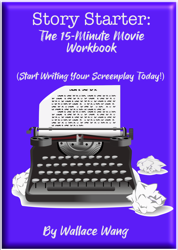Everyone wants to write a great story, but far too many writers are simply hoping and praying their idea will somehow magically work out. When you rely on hope as a strategy, you’ve already failed.
If you want to write a great story, start by identifying the three key parts that make up every great story:
- A compelling hero
- An interesting setting
- A unique “hook”
A compelling hero is a must because nobody wants to follow a story about a boring person and a boring person is someone who doesn’t do anything. Bad movies often make the mistake that the hero needs to be hyper active and an over the top personality. Yet the most compelling heroes can be shy (“Napoleon Dynamite”) or seemingly powerless (“Little Miss Sunshine”). What makes a hero compelling is that they actively pursue a meaningful goal and keep pursuing that goal with the rabid persistence of a pit bull until they get what they want or die trying.
Watching someone constantly struggle to achieve a specific goal is far more interesting than watching a passive character who does nothing because they have no direction. So always make your hero active in pursuing a specific goal that they can’t get until the very end.
Once you have a compelling hero, the second part of a great story is a unique setting. Putting a compelling hero in a flat, dull setting never works. The setting must always work against the hero because that’s what makes an interesting story.
Think of “The Hunger Games” where the hero is a spunky teenage girl who’s oppressed by a dystopian government that forces her to struggle to survive in a poor mining community.
Put this type of hero in a world that fully supports her and fails to challenge her in any way and you’ve basically deflated your entire story. Put this type of hero in a dystopian world that’s slowly trying to crush her and you have a far more interesting background and setting.
Now if you combine your compelling hero with a challenging setting, you’ll already have the foundation for a story, but not quite yet. To complete your story, you need a unique “hook”.
This “hook” is some event that sets your story in motion like the start of an avalanche at the top of a mountain. Once this trigger event occurs, the rest of the story can’t help but play itself out until the very end.
In “The Hunger Games”, the hero is a teenage girl struggling to survive in a poor mining community oppressed by a dystopian government. So far, this is the start of a potentially interesting story, but not an interesting story in itself. What’s needed is a “hook” is what forces the hero to fight against the dystopian government.
Great story = Compelling hero + oppressive setting + “hook”
This “hook” is some action or event that inevitably binds the hero to the oppressive setting to the point where they have absolutely no choice but to fight.
In “The Hunger Games”, the hero, Katniss Everdeen, could have just spend the rest of her life grumbling and complaining about the oppressive dystopian government, but that would create a boring story. The “hook” occurs when Katniss makes the conscious decision to volunteer in her little sister’s place to fight in the Hunger Games.
That decision means Katniss has no choice but to actively fight against the oppressive government or die trying.
That “hook” is what gets the story going and creates the great unanswered question, “Will Katniss survive or not?”
Every great story has a compelling hero, an oppressive setting, and a unique “hook”. In “Star Wars”, Luke is a likable hero stuck on a desolate planet that’s more like a prison keeping him from living a life of adventure.
Then the “hook” occurs when Darth Vader’s storm troopers kill his aunt and uncle and leave Luke with no choice but to follow Obi-wan in taking R2D2 to Princess Leia’s planet.
So when coming up with your own stories, start with a compelling hero. Then create an oppressive setting that actively works against your hero. Finally, think of a unique “hook” that forces your hero into fighting against the forces creating their oppressive setting.
When you find the unique “hook” for your story, you’ve essentially found your story.
Sign up to take a FREE course about how to write scenes in a screenplay.

